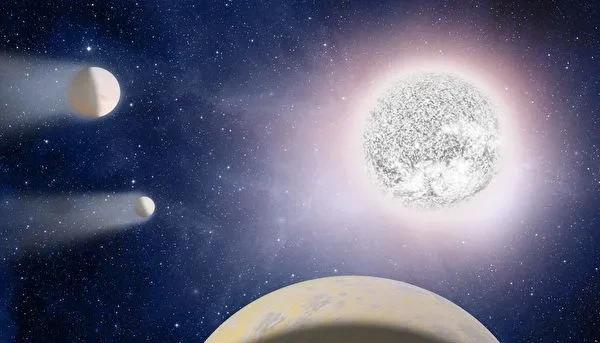Scientists see the final moments of planetary debris for the first time
Astronomers at the University of Warwick in the United Kingdom first observed the moment when debris from a torn planet hit the surface of a white dwarf, the last time the planet's debris was reached. Scientists estimate that this planetary system has been around for billions of years.
The research team used X-rays to detect the process by which rocky and gaseous material hits a white dwarf and is swallowed up by the white dwarf. This material is the remnants of planetary systems that were destroyed after the death of their stars. This is the first direct measurement of the accretion of rocky material onto a white dwarf.
The findings confirm circumstantial evidence from more than a thousand stars accumulated over the decades to date.
Most stars, including the Sun, will eventually become white dwarfs. More than 300,000 white dwarfs have been found in our Milky Way, many of which are believed to be accruing debris from planets and other objects that once orbited them.
For decades, astronomers have used spectra of optical and ultraviolet wavelengths to measure the abundance of elements on a star's surface and calculate its source from it. There is indirect evidence in the spectrum that stars are accreting surrounding material. These observations show that about 25-50% of white dwarfs contain heavy elements such as iron, calcium, and magnesium mixed in their atmospheres.
Until now, though, astronomers haven't seen rocky matter pulled into stars.
Dr Tim Cunningham of the University of Warwick said in a statement: "We are finally seeing that matter has actually entered the atmosphere of a star. This is the first time we have been able to derive the accretion rate of a detailed model that does not depend on the atmosphere of a white dwarf. Interestingly, it fits well with previous theories. ”
"Previously, the measurement of accretion rate used spectroscopy and relied on a model of white dwarf stars. These are numerical models that calculate the rate at which elements sink into stars from the atmosphere and tell you how much is the accretion rate that falls into the atmosphere. You can then extrapolate and calculate how many elements are in the proto-object, whether it's a planet, a moon, or an asteroid. Dr Cunningham added.
A white dwarf is a star that burns up all its fuel and sheds its outer layer of material, potentially interfering with or destroying any celestial bodies orbiting it in the process. When material from these objects is pulled into the star at a high enough speed, it violently hits the star's surface, forming a plasma heated by shock waves.
This plasma has a temperature between 100,000 and 1 million Kelvin and is then deposited on the surface of the white dwarf. When it cools, it emits observable X-rays. X-rays are higher-energy radiation than light that we can see with the naked eye. In astronomy, X-rays are key high-energy signals for matter to fall into exotic objects such as black holes and neutron stars.
Observing these X-rays is very challenging. So astronomers used the Chandra X-ray Observatory (Chandra X-ray Servingory) to analyze the neighboring white dwarf star G29-38.
The new study also confirms that many mysteries in the universe are not visible to the naked eye, but require the use of other means, such as high-energy radiation like X-rays, to be visible.
In the above statement, Dr Cunningham said: "What is really exciting about this result is that we are using different wavelengths, aka X-rays, to help us explore completely different types of physical mechanisms. The discovery provides the first direct evidence that white dwarfs are currently accruing remnants of old planetary systems. Detecting accretion in this way offers a new technique through which we can study these systems, giving us a glimpse into the fate of thousands of known exoplanet systems as well as the solar system. ”
